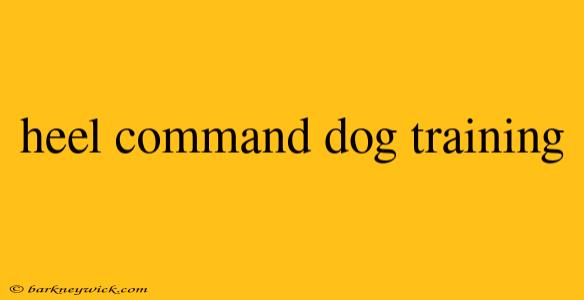The Power of "Heel" : A Dog Trainer's Guide to Mastering This Essential Command
I remember the day I first attempted teaching my dog "heel" – it was a frustrating mess. My goofy puppy, a bundle of chaotic energy, would happily trot alongside me for a few steps before veering off to chase squirrels or sniff every fascinating blade of grass. It felt like a game of tug-of-war, with me constantly pulling him back to my side. But over time, with patience and consistency, we finally mastered it, and the joy of a well-behaved dog walking by my side is a feeling I wouldn't trade for the world.
Why "Heel" is Crucial
In my opinion, the "heel" command is one of the most important commands a dog can learn. It signifies not just obedience but also a strong bond between you and your canine companion. Imagine this: you're strolling through a bustling park, enjoying the fresh air and vibrant sights, with your dog calmly by your side, responsive to your every direction. That's the power of a well-trained "heel". It makes walking a pleasure, reduces the chances of your dog pulling or getting into trouble, and builds trust and communication.
Beyond Basic Obedience
Beyond the obvious benefits of safe and controlled walks, "heel" is also a foundation for more advanced training. It teaches your dog to focus on you, pay attention to your cues, and stay in control in various situations. This is especially useful in scenarios like agility courses, competitive obedience, or simply managing your dog in crowded public spaces.
How to Teach "Heel"
Now, let's get into the nitty-gritty of teaching this essential command. The process involves three crucial steps:
1. Start Simple: Begin by rewarding your dog for walking beside you for even a few steps. Use high-value treats and praise.
2. Consistency is Key: Practice "heel" in short bursts throughout the day, gradually increasing the distance and duration.
3. Be Patient: Don't get discouraged by setbacks. Remember, dogs learn at their own pace.
Using a Clicker
A helpful tool for teaching "heel" is a clicker, popularized by Karen Pryor, a renowned animal behaviorist. The clicker serves as a marker, telling your dog they've done something right, followed by a reward.
Tips for Success
- Keep it fun! Training sessions should be positive and enjoyable for both you and your dog.
- Don't punish mistakes. Focus on rewarding desired behavior.
- Practice in different environments. This helps your dog generalize the command.
- Consult a professional trainer if you're struggling. They can offer personalized guidance and advice.
The End Result
Mastering the "heel" command isn't about achieving perfection, but about building a strong connection with your dog. The journey is just as important as the destination. By being patient, consistent, and creative, you can turn a chaotic puppy into a well-mannered companion who walks by your side with pride. Remember, a well-trained dog is a happy dog, and a happy dog makes for a happy owner.
